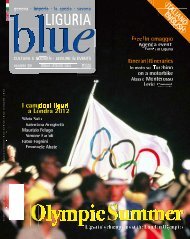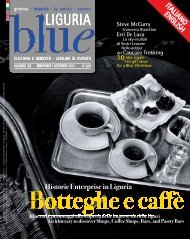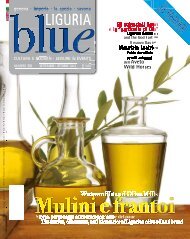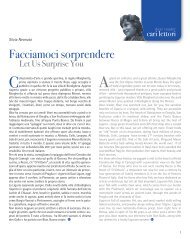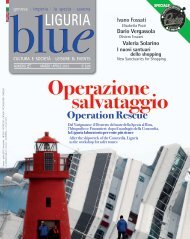Download PDF - Blue Liguria - Sagep
Download PDF - Blue Liguria - Sagep
Download PDF - Blue Liguria - Sagep
You also want an ePaper? Increase the reach of your titles
YUMPU automatically turns print PDFs into web optimized ePapers that Google loves.
cover<br />
blue<br />
Jeans per Gesù e Giuda<br />
Jeans for Jesus and Judas<br />
Esposti al Museo Diocesano del capoluogo i 14 teli in lino tinto<br />
di blu con l’indaco e dipinti a biacca soprannominati “Blu di<br />
Genova” e considerati gli antenati della stoffa jeans.<br />
Raffigurano la passione di Cristo<br />
On exhibition at the Diocesan Museum of Genoa are 14<br />
linen canvases dyed blue with indigo, considered to be the<br />
original blue jean material. Called “Blu di Genova” they are<br />
painted with white lead to depict the Passion of Christ<br />
Il dolore delle donne chine sul<br />
corpo del Cristo morto; il caos e<br />
la violenza della scena del bacio di<br />
Giuda; i volti ieratici degli apostoli<br />
che circondano Gesù. Sono esposti<br />
in due sale al primo piano del<br />
Museo Diocesano di Genova,<br />
illuminati da una luce soffusa, i 14<br />
teli soprannominati “Blu di<br />
Genova” e considerati gli antenati<br />
della stoffa jeans, unico esempio,<br />
insieme al ciclo della passione di<br />
Reims, dell’antica abitudine di<br />
velare gli altari delle chiese<br />
durante la Quaresima con scene<br />
della morte e della resurrezione di<br />
Cristo, davanti alle quali si<br />
svolgevano anche le sacre<br />
rappresentazioni.<br />
«I teli, di proprietà della<br />
Soprintendenza, sono in lino tinto<br />
di blu con l’indaco e dipinti a<br />
biacca. Il loro scopo era di<br />
emozionare i fedeli e spingerli alla<br />
penitenza», spiega la storica<br />
dell’arte Marzia Cataldi Gallo,<br />
esperta di tessuti e autrice del<br />
volume Passione in blu. I teli con<br />
storie della passione del XVI secolo<br />
a Genova (edizioni De Ferrari).<br />
Pensati per l’Abbazia di San Nicolò<br />
del Boschetto in Valpolcevera,<br />
dove venivano montati in<br />
occasione della Quaresima su una<br />
struttura di legno, dando origine a<br />
una chiesa nella chiesa, i teli si<br />
dividono in tre gruppi: i più<br />
grandi, oltre 3 metri quadri<br />
ciascuno, risalgono al primo<br />
trentennio del Cinquecento, opera<br />
di pittori di scuola lombarda<br />
ispirati alle incisioni di Albrecht<br />
The pain of the women who lean<br />
over Christ’s dead body. The chaos<br />
and the violence of the scene of the<br />
Kiss of Judas. The pious faces of the<br />
apostles who surround Jesus.<br />
Illuminated by diffused light, all are<br />
exposed in two halls on the first floor<br />
of the Diocesan Museum of Genoa.<br />
These 14 canvases, called “Blu di<br />
Genova” (<strong>Blue</strong> of Genoa), are<br />
considered to be the ancestors of<br />
jeans material. Together with the<br />
Cycle of Passion in Reims, they are a<br />
unique example of the ancient habit<br />
of covering altars during Lent with<br />
scenes from the death and the<br />
resurrection of Christ, in front of<br />
which the sacred acts were<br />
performed.<br />
“The 14 canvases are the property of<br />
the Superintendence. They are made<br />
of linen, dyed blue with indigo and<br />
painted with white lead. Their<br />
purpose was to excite the emotions<br />
of the faithful and push them<br />
towards penitence”, explains art<br />
historian Marzia Cataldi Gallo,<br />
textile expert and the author of the<br />
book, Passione in blu. I teli con<br />
storie della passione del XVI secolo a<br />
Genova (Passion in <strong>Blue</strong>: canvases<br />
telling of the Passion from the XVI<br />
Century in Genoa, Edizioni De<br />
Ferrari). Originally made for the<br />
Abbey of San Nicolò del Boschetto<br />
in Valpolcevera, they would be<br />
mounted during Lent on a wood<br />
structure which created a church in<br />
a church. The canvases are divided<br />
into three groups. The biggest ones,<br />
over 3 square meters each, date to<br />
the first thirty years of the 1500s, the<br />
Dürer. Poi il “Cristo deriso” e la<br />
“Deposizione” si devono a una<br />
personalità più matura, che<br />
risente dell’influenza di Giulio<br />
Romano e Perin del Vaga, infine<br />
gli “Angeli turiferari”, il “Volto<br />
Santo” e i “Monaci in preghiera”<br />
appartengono a un periodo più<br />
tardo, fra il XVII e il XVIII secolo.<br />
«Mentre i nobili e i ricchi<br />
tradizionalmente vestivano di seta,<br />
i ceti medi e bassi nel Medioevo<br />
indossavano tessuti che<br />
mescolavano la lana al cotone, al<br />
lino e alla canapa», prosegue<br />
Cataldi Gallo. E Genova, da sempre<br />
importante centro di produzione<br />
di stoffe,le spediva via mare dentro<br />
casse contrassegnate con la scritta<br />
“jean”, per indicarne la<br />
provenienza, in tutta Europa e<br />
soprattutto in Inghilterra, dove<br />
erano particolarmente apprezzate.<br />
Da qui, e dalla diffusione grazie<br />
alla scoperta dell’America della<br />
tintura blu con l’indaco, utilizzata<br />
anche per questi teli della<br />
Passione, al boom del blue jeans<br />
utilizzato prima per le tute da<br />
lavoro e poi come capo modaiolo il<br />
passo è breve. Anzi brevissimo.<br />
Lucia Compagnino<br />
work of painters of the Lombard<br />
School, inspired by the engravings by<br />
Albrecht Dürer. Then the “Christ<br />
Mocked” and the “Deposition” are by<br />
a more mature artist influenced by<br />
Giulio Romano and Perin del Vaga.<br />
And the last group, “The Incense-<br />
Bearing Angels”, “The Sacred Face”,<br />
and “The Monks in Prayer” belong to<br />
a later period, between the XVII and<br />
XVIII centuries.<br />
“While the nobles and the rich<br />
traditionally wore silks, the middle<br />
and lower classes in the Middle Ages<br />
wore fabrics which mixed cotton and<br />
wool, linen and hemp,” continues<br />
Cataldi Gallo. And Genoa, which has<br />
always been an important center of<br />
textile production, would then send<br />
fabric by sea in crates with the<br />
writing “genes” (“Genoa” in French)<br />
to indicate origin. Across Europe, and<br />
especially in England, these textiles<br />
were particularly appreciated. From<br />
here, also thanks to the discovery of<br />
America which spread the use of<br />
indigo blue dyes – the same used for<br />
these canvases of the Passion – came<br />
the boom in the use of “genes”, now<br />
“jeans” material, first for work<br />
clothes, then, just a short step, to<br />
fashion. A very short step.<br />
75



